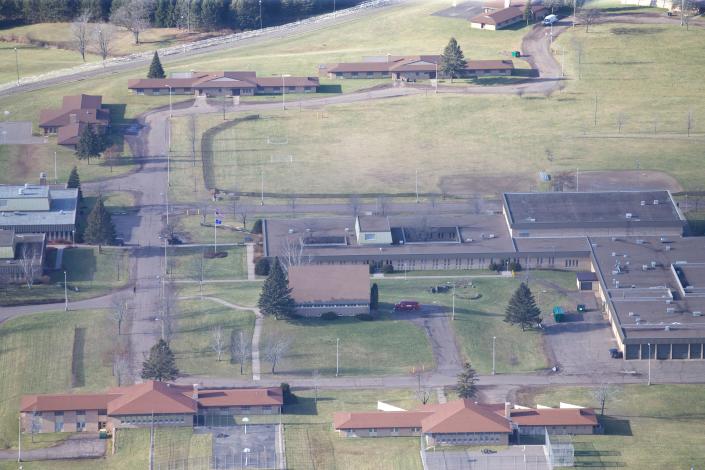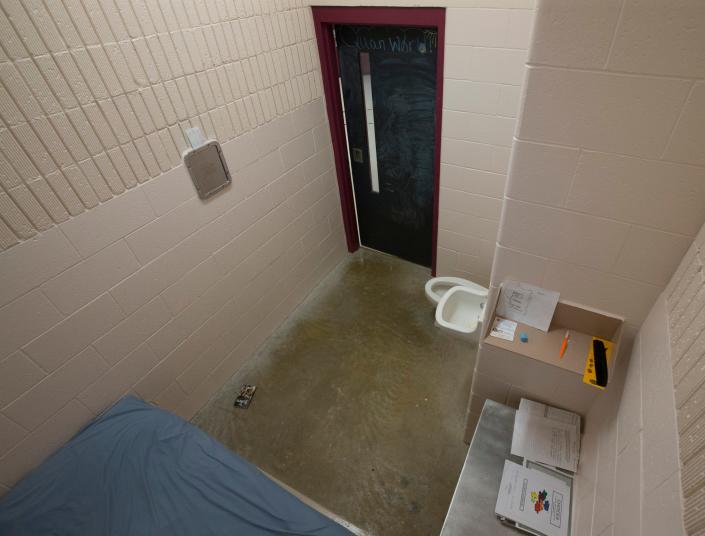A new youth prison is coming to Milwaukee but hurdles remain. Here’s a look at the closing of Lincoln Hills and what comes next in Milwaukee
[ad_1]

A new youth prison is coming to Milwaukee. It’s part of a plan set in motion four years ago when lawmakers promised to close Lincoln Hills, the state’s long-troubled youth prison north of Wausau. The new facility is coming at a time when Milwaukee County’s youth justice system is under intense pressure. Here’s a look at how we got here, what is yet to be decided and what this means for youth justice in Milwaukee County.
What is Lincoln Hills?
Lincoln Hills School for Boys and Copper Lake School for Girls is a youth prison located on a joint campus 30 miles north of Wausau. Most inmates are in their mid to late-teens. Typically, they have committed serious, sometimes violent crimes — including homicide and robbery — or have had repeated run-ins with the law and didn’t turn their behavior around after being sent to treatment centers or group homes. Built to hold more than 500 inmates, it housed nearly 70 on Monday, including 13 girls and 56 boys, according to the state Department of Corrections.
Why did lawmakers want to close it?
For most of the last decade, the prison was plagued by problems that made it dangerous for both young inmates and staff. It was the subject of state and federal investigations and multiple lawsuits alleging abuse, including a class action that forced major changes to the prison’s practices. Inmates were previously held in isolation for weeks at a time, and pepper spray was used as a punishment.
The state has spent more than $25 million in legal fees and settlements with former inmates, including a girl who was severely brain-damaged in a suicide attempt that guards were slow to respond to.
Former Gov. Scott Walker put forward a plan to close the prison during an unsuccessful reelection bid in 2018, six years after his office was first notified of trouble at the facility.
What was the plan for closing it?
The plan was laid out in Act 185, the legislation proposed by Walker and passed unanimously by lawmakers in 2018. The law required the closure of Lincoln Hills by 2021 and the building of new, smaller facilities around the state to replace it — some run by counties and some by the Department of Corrections. But four years later, none of the replacement facilities have been built and Lincoln Hills remains open, despite the July 1, 2021, deadline to close it.
What does that mean for Milwaukee County?
Milwaukee County Children’s Court judges are still sending young offenders to Lincoln Hills, even as the legality of doing so is unclear. Generally, judges try to avoid sending teens to Lincoln Hills, but they will in some of the most serious cases. Judges say that without the replacement facilities, they have virtually nowhere else to send those with the highest needs.
It’s also costing the county more to send teens to Lincoln Hills than it did a year ago. That’s because the cost of housing most youths at the prison nearly doubled — from $615 to $1,154 per person per day, a rate established in the state’s biennial budget. That amounts to about $420,000 for a yearlong stay.
In March, county officials were projecting a $6 million deficit because of the high cost and the unexpectedly high number of youths judges are sending to Lincoln Hills this year. Judges say their options are limited at a time of rising crime and caseloads.
What’s behind the rise in crime?
Most of the rise in youth arrests in Milwaukee had to do with vehicle theft and related crimes.
In 2021, Milwaukee police made 926 arrests of people age 16 and younger, the most since 2016, according to arrest data
from the Milwaukee Police Department. The bulk of the arrests was for operating a vehicle without the owner’s consent, fleeing from police and other related crimes.
It’s a trend reflected in other cities across the country that have reported an increase in carjackings involving young people.
What options, besides Lincoln Hills, do judges have?

The most serious offenders might be sent to Lincoln Hills — or they might be sent to the Milwaukee County Accountability Program, or MCAP. It’s a county-run program that judges sometimes turn to instead of Lincoln Hills. Like Lincoln Hills, the program starts in a locked setting — the first half of the program is in detention at the county’s Vel R. Phillips Youth & Family Justice Center in Wauwatosa.
Unlike Lincoln Hills, the program is in Milwaukee County, close to teens’ families and communities. MCAP is meant to give teens with high needs the tools to make better decisions and stay on a crime-free path through intensive therapy, mentoring, group counseling and other services.
The problem is that MCAP is full. In recent months, judges have been putting young people into the program faster than can be moved through the one-year program. Some young people waiting for a spot to open up in the program have waited in detention for months.
Who is affected?
Judge Laura Crivello, the presiding judge of Milwaukee County Children’s Court, said the goal is to rehabilitate youths and reduce recidivism. It doesn’t help, she said, when youth are simply sitting in detention on a waitlist.
A 16-year-old boy who was ordered into MCAP in January still hadn’t gotten a single service from it by March. He waited more than two months for a spot to open up in the program — a wait he spent in detention at the Vel Phillips Center. At one point, he was one of more than 20 youths on the waitlist.
During that time, he was not getting the MCAP tools considered key to changing his behavior. By March, he was so frustrated with the stagnation that he asked a judge to move him to Lincoln Hills so he could begin getting services, a county human service worker said during a court hearing. The 16-year-old ultimately withdrew that request when he found out he had been moved up on the MCAP waitlist, his attorney said.
Why not expand MCAP?
County officials say that Act 185 also put a limit on the number of youths they can have in the in-custody phase of MCAP at one time. They say they cannot have more than 24 youths participating in the program while in detention. There are additional youths outside of detention in the in-community phase of the program.
What’s next?

Last month, Gov. Tony Evers signed a new law funding a new, state-run youth prison in Milwaukee County. The $42 million facility is a necessary step in the process of closing Lincoln Hills. The hope is that a facility closer to young people’s communities and families will better set them up for success once they re-enter the community.
The state is also expanding the Mendota Juvenile Treatment Center, which currently has room for 29 boys and is the only other state correctional facility beside the Lincoln Hills complex. The expansion is a step toward reducing the youth population at Lincoln Hills and will ultimately help in closing the prison complex.
Mendota, which provides mental health treatment, houses teens only if there are clinical reasons to do so, so not all of those held at the Lincoln Hills campus could be sent there.
The state Department of Health Services broke ground on the project in March and is expected to open the expanded f
acility in 2025. The $66 million project will construct a unit to house up to 30 more boys and — for the first time — 20 girls. When the expansion is completed, Mendota will have room to house 93 youths, including 14 more boys on an existing wing that has been used for other purposes, according to DHS.
Where will the prison go?

This is yet to be finalized, but state corrections officials plan to build the new facility on the site of the current Felmers O. Chaney Correctional Center northwest of downtown Milwaukee. That plan has been met with opposition from several groups — including the ACLU of Wisconsin, Youth Justice Milwaukee and Ex-Incarcerated People Organizing of Wisconsin — and Sen. Lena Taylor, D-Milwaukee. They say the adult, re-entry beds at the Chaney Center are vital to helping adult men successfully reintegrate into society from prison.
More: A law calls for a new youth prison in Milwaukee County. Why isn’t the location settled?
When will the new prison open?
It could take years to build. Department of Corrections spokesman John Beard said “many more steps need to happen” to carry out the plan, including site approval processes at the local and state level and then approval by another round of state officials.
Under the law funding the new facility, the Milwaukee Common Council would likely have to sign off on the facility if it is located in the city. Ald. Russell Stamper, whose district includes Felmers Chaney, told the Milwaukee Journal Sentinel he would oppose plans to replace the Chaney Center with a juvenile facility.
What about the county-run youth facilities?
Racine County is planning to build a county-run youth correctional facility using grant money from a state program created by Act 185, county officials said. Officials said they hope to break ground next year and to open the facility in 2024. The facility will serve dual purposes as a correctional facility for youth found delinquent of crimes and as a detention facility for youth from Racine and surrounding counties being held temporarily or while awaiting trial.
Sarah Volpenhein is a Report for America corps reporter who focuses on news of value to underserved communities for the Milwaukee Journal Sentinel. Email her at [email protected]. Please consider supporting journalism that informs our democracy with a tax-deductible gift to this reporting effort at JSOnline.com/RFA.
About this feature
This is a weekly feature for online and Sunday print readers delving into an issue in the news and explaining the actions of policymakers. Email suggestions for future topics to [email protected].
Our subscribers make this reporting possible. Please consider supporting local journalism by subscribing to the Journal Sentinel at jsonline.com/deal.
DOWNLOAD THE APP: Get the latest news, sports and more
This article originally appeared on Milwaukee Journal Sentinel: What the Lincoln Hills closing means for a Milwaukee youth prison
[ad_2]
Source link





